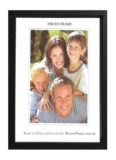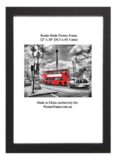Just before Christmas, a lady Customer brought a medium-sized, black-and-white print which had been wrapped and stored away from sunlight since 1967. She was excited at having discovered the print which was the last of a set of three her artist father had created, and now wanted it framed in a "safe" picture frame. Alas, the set of 3 prints was somehow mislaid and became separated over the years, and only the first 2 prints had been framed. The third and last print was the one brought in to us for farming and the Customer wanted us match the framing of the other two. As she ... unwrapped the newly-found third print of the set on our picture counter, she was surprised and remarked on how white and pristine it looked. She then compared it to the other two already framed and became visibly dismayed at the difference. Both ourselves and the Customer saw that, compared to the unframed ones, the last print was noticeably and distinctly yellow.
wrapped and stored away from sunlight since 1967. She was excited at having discovered the print which was the last of a set of three her artist father had created, and now wanted it framed in a "safe" picture frame. Alas, the set of 3 prints was somehow mislaid and became separated over the years, and only the first 2 prints had been framed. The third and last print was the one brought in to us for farming and the Customer wanted us match the framing of the other two. As she ... unwrapped the newly-found third print of the set on our picture counter, she was surprised and remarked on how white and pristine it looked. She then compared it to the other two already framed and became visibly dismayed at the difference. Both ourselves and the Customer saw that, compared to the unframed ones, the last print was noticeably and distinctly yellow.
The yellowing wasn’t slight either, it was a definite hue bordering on the light tan. Our Customer was shocked at the difference, she asked us what caused the colour change and how did that come about, considering that all 3 prints were pulled with the same paper, at the same time and perfectly equal at the time of printing.
Suspecting what had happened, we then inspected the picture frames of the other two framed prints and soon confirmed both the cause and reason for the discolouring. We found that the first two prints had been cheaply framed in even cheaper department stores frames. The acid frame contents had, over time, reacted with sunlight, making the paper go yellow.
We have dwelled on this subject on our prior post of "Updating, Uplifting and Upgrading Picture Frames" This is a regrettable event which we have encountered countless times, that of Customers bringing in paper art damaged by acid burn caused by acidic materials.
The acidic materials are not always the wood or the MDF backing of the frames, quite often, it’s the paper itself that contains lignin, a wood-derived component that is very acidic . Paper is largely milled from wooden materials, consisting mostly of white cellulose, and the wood from which these come from contain a darker component element knows as lignin.
This organic polymer can make up to 33% of the lignocellullose, the material from which paper is manufactured. It is lignin which, when it is exposed to light and air, turns that soft, nice white paper into brittle, fragile, yellow sheets of weakened and degraded paper.
This polymeric element is inherent to the structure of wood and its derivatives such as logs, timber and lumber and may be seen as the organic glue that ties, binds and strengthens the cellulose and all other fibres together.
And while it is good that it be in the timber, it’s not so good that it be present in art paper, or any paper, as it oxidizes it, yellowing it and embrittling it. This is a problem that we have discussed before on our prior post "On Cleaning Paper Art Prior to Picture Framing".
Let’s take the ubiquitous newsprint for instance. This paper product has to be produced as economically as possible, at the lowest possible cost. Typically, at paper mills, the wood pulp to be milled and rolled for news-sheets is only partially treated and the lignin remains.
This element activates when oxygen is present and generates chromophores (carriers of colours) which change the paper to yellow. Again, newsprint is made for a cheap and disposable consumer product such as newspaper which will relatively quickly turn to yellow when exposed to either sun or artificial light.
Additional treatments would add to production costs and besides, the shelf or print life of newspapers is ephemeral. Finer papers, such as art and drawing papers, on the other hand, cost more and Customers pay premium prices which allows for the partial or whole neutralization of lignin by way of chemical solvent, or bleaching. This chemical whitening, or delignification process, refines coarse cellulose into white cellulose without the darker and noxious lignin.
Aside from this chemical bleaching, yet another way is to combat lignin acid damage is to add or buffer the wood pulp with alkaline compounds so as neutralize the lignin when paper it is being manufactured.
To sum up, it is lignin that, either as naturally-occurring or embedded in the art carrier or its materials, when exposed to light, discolours, drawings, photos, documents or any art on paper. Even the most precious, cherished, beautifully framed, or expensive art on paper will yellow and self-destruct with time unless prevention is planned and acted upon.
Adding to the acidity conundrum, other acidic materials, in addition to the paper itself and backing board, often can and do compound and worsen this problem. These materials are often the window mount, or window mat, and the moulding of the picture frame itself.
By and large the differences between acidic material in ready-made picture frames and acid-free custom picture frames have already been elucidated in this post "7 Reasons Why Custom Picture Frames Are better Than Ready-Made Picture Frames".
It would be repetitive to iterate the same technical explanations here, but suffice to say that eliminating or avoiding any acidic materials to in contact with the artwork largely obviates the damage from acid burn. With regard to the window mat, existing frames can often be quickly and easily checked if the mat or mats within are acidic.
A close inspection of the colour of the window’s bevel cut will reveal if they are white or not. If white, chances are the mat is acid-free and therefore safe, if yellowing, tan or brown it is likely to be acidic and unsafe. Yet another give-away of acids is the presence of any “browning” anywhere along the four sides of the mat, though by the time this is noticeable, the damage incurred may be extensive, permanent and irreversible. This type of matting makes anything but a "safe" picture frame.
In such cases, it is recommended that art be disassembled from its acidic receptacle and stored in an unlit, arid and cool location until re-framed with safe materials. This removal will, at the very least, stop the ongoing deterioration and degradation process.
A last, though somewhat unlikely source of lignin contamination is the timber moulding making up a picture frame. Mouldings are rarely treated for lining removal as it’s not practicable or economical . Further, since the frame seldom touches the artwork itself, as in the case of an average matted sketch, such a contamination is rare.
However, in the rare cases where the artwork is in direct contact with the acidic frame, a frame’s rebates can be lined or sealed with museum rag strips other sealants to prevent said impurities from migrating to the art. Now that enough has been said to enlighten most readers on what lignin is and how it can ‘burn” and “yellow” art, let’s expand on how this damage can be avoided.
This avoidance is easily achieved by framing art in picture frames and picture framing methods that safely avoid, obviate, prevent or deter acid migration. To put it in another way, this would be the answer to this post “Is there an anti-yellowing, "safe" picture frame ?.
We can begin to construct an answer by explaining that with most picture framing, the materials to be safeguarded are the a) backing board, b) the window mat, c) the hinges, d) the glass and rarely, e) the picture frame itself. Pertinently, the standards summarizing both the materials and processes are also detailed at Picture Frames and Picture Framing Standards
Dwelling on the a) backing board. This aspect has already been alluded to earlier on this post , however, and to summarize, we suggest avoiding wood backings, MDF backboards or any type of paper boards which are cardboard, dark, woody and likely to contain harmful lignin. A "safe" picture frame will never contain this type of material.
When picture framing a valuable or cherished piece of art, museum-quality, conservation-quality or at the very least, acid-free foam board, foam-core or barrier paper should be used. We feel any professional picture framer ought to readily concur with this suggestion.
Now to b) the window mat. The merits and properties of this picture framing component has been scrutinized by us several times before. With regard to acidic window mats, the post “Updating, uplifting and upgrading picture frames” explains what types of window mats should and should not be used depending on the nature of the artwork.
Nevertheless and, broadly speaking, the same criteria applies here as to the preceding component, the backing board, and that is, museum-quality, conservation-quality or at the very least, acid-free mat board. As to c) the hinges. Again, we also have written posts about his component before.
The hinge is the device which attaches paper art either to a backing board or to the underside of a window mat. It serves to hold the artwork in place while allowing it to expand and contract, as do all loose papers. In the page “What picture framing mounting is and why it’s needed” at the section “The conservation hinging method” where one type of these hinges is shown.
While hinges will vary in shape, design and materials their purpose remains the same, and as explained previously. Needless to say, all hinging material, whether tissue, or pressure-sensitive or not, is at the very least acid-free, and most often, of conservation or museum quality.
With regard to d) the glass. This is a very important component in picture frames and we have devoted a page here titled “ Glazing Picture Frames with Glass and Other Glazing Materials”
This page contains all the foremost information pertaining to picture frame glazing and need not be iterated herein. It will be emphasized though that sunlight will cause the lignin within any acidic material to react and “burn” any art therein contained unless Ultra-Violet (U.V.) glass is used since it filters out, or blocks, around 98% of harmful rays.
Both clear float glass and diffused ( non-reflective) glass allow roughly 50% or more of harmful U.V. rays to come though and should be avoided for precious, valuable, significant, or cherished art. And lastly, to e) the picture frame itself. As mentioned beforehand, it is quite rare for the art to actually come in contact with, or to touch the wood of the timber moulding.
Notwithstanding this qualification, there may be cases where no window mat is used or that the picture frame itself be the same size, or slightly undersize to the actual art dimensions, in which case there may well be contact, either upon framing, or later, when ambient atmospheric factors may cause the art medium to expand.
To forestall acid migration in these, albeit, rare instances, covering or lining the picture frame’ height and with rebates with acid-free, conservation, or museum-quality materials such as rag-mat matboard strips will prevent this harmful acidic transfer.
The sum of all this information is that the only possible, anti-yellowing, safe picture frame a Customer will find is a custom-made on by a custom picture framer to the Customer’s requirement and specifications. An anti-yellowing, safe picture frame will never be found off-the-shelf or a ready-made-poster-frame at a large department store, photographic supplies shop, 2-dollar shop or discount shop.
The reason for this is that these retailers invariably stock the cheapest frames, made with the cheapest materials to be sold at the cheapest prices. To put it in another way, all such frames have MDF lignin-loaded backings and papers, with acidic windows mats and cheap, clear sheet glass. This is the perfect recipe for aging, yellowing and embrittling art, and almost guarantees progressive and inevitable dilapidation, deterioration and disintegration of any and paper art therein framed. Thank you for reading this post "Is there an anti-yellowing, "safe" picture frame ?".









Hmmmm .. wish I’d read something like this post here years ago. I have an original 1969 Richmond premiership poster signed by Kevin Sheedy that was worth 2K, or more, I reckon. Anyway the missus chucked a spas to frame it properly like I orirignally wanted so we ended up shoving it into one of those el cheapo department store frames and then lent it out. That was quite a few years back. I since got the frame back from my son who’s gone overseas and was shocked at how mustardy yellow it’d become! I took it to a picture framing place and they explained why that happened and it was pretty much what’s being said here. Anyway it was so brittle and delicate that it cracked on being handled. The framer said I would have to go to an art conservator, that’s how bad it was. But I’m too scared to take it there, those specialists charge you hundreds just to look at something, I’m told. Any advice?